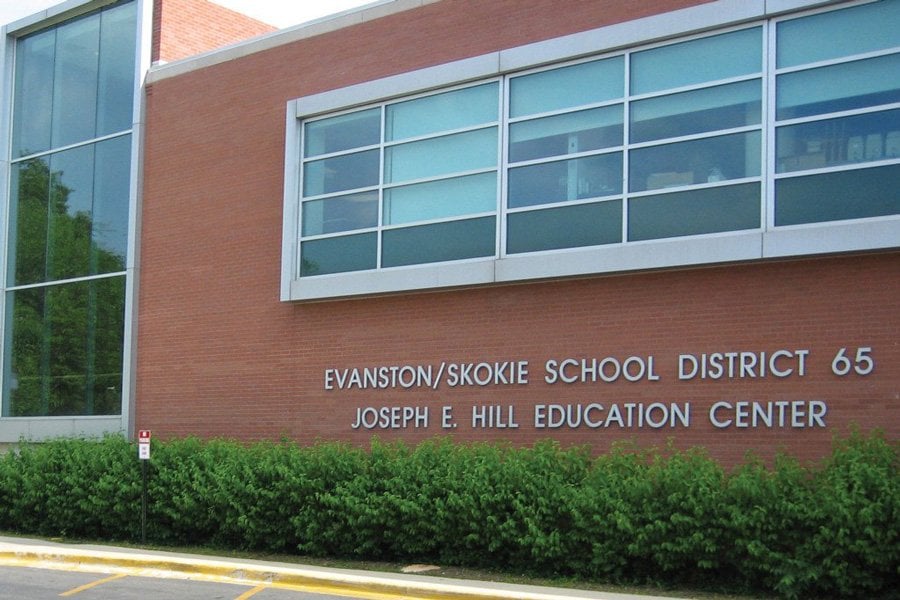District 65 Policy Committee meeting presents new achievement data
Daily file photo by Patrick Svitek
The Evanston/Skokie School District 65 Education Center, at 1500 McDaniel Avenue. The Evanston/Skokie School District 65 Policy Committee met and addressed new data on the district’s achievement metrics.
April 13, 2021
Evanston/Skokie School District 65’s achievement gap persists, according to the district’s annual achievement metrics presentation, which took place during Monday’s meeting.
Kylie Klein, the district’s director of research, accountability and data, shared data from the district’s 2019-2020 Achievement and Accountability Report.
The data showed significant disparities between White students and Black and brown students across the district, following a pattern found across years of achievement reports. Since the inception of the report, district officials have attempted to implement plans to bridge the achievement gap, but this year, students saw decreases in multiple elements of their studies.
However, Klein said this data is not representative of overall student performance. She recognized the limitations of this year’s research due to COVID-19 and the transition to remote learning.
“(The data are) not fully complete,” Klein said. “We decided to include it because we wanted to provide as much information as possible, given the current circumstances of the situation, and wanted to be as transparent and informative as we could be.”
According to the report, 90 percent of White students in the district were at or above the 50th percentile for proficiency in English Language Arts, while only 48 percent of Hispanic students and 43 percent of Black students met the same benchmark. In math proficiency, 86 percent of White students were at or above 50th percentile compared to 46 percent of Hispanic students and 32 percent of Black students.
The percentage of students making expected gains in the Developmental Reading Assessment, which monitors student reading levels, dropped in every grade level in 2020. The district also saw a drop in the Illinois Snapshot of Early Literacy, measuring kindergarten readiness, from 50 percent to 39 percent of students meeting expected gains.
Board President Anya Tanyavutti said in the past, district leaders focused their attention on the early literacy framework for accelerating the learning of Black and brown students. As the district looks forward, she said it’s important to evaluate the metrics with which student achievement is measured.
“What is our theory of change that we should be looking for data indicators, as a board, to measure how we are accelerating learning for Black and brown students?” Tanyavutti asked. “Because I will admit that it is heartbreaking, every time I see this data, that it does not capture the full aptitude of our students with marginalized identities.”
District 65 Executive Director of Black Student Success Dr. LaTarsha Green said the district has done extensive reflection and examination of its practices and will now focus on continually improving, evaluating and making adjustments to processes put in place.
One such program working to bridge the gap between district administration and schools themselves is the Reality Check strategy — a program developed by District 65 Superintendent Devon Horton. Through the program, schools have the opportunity to gauge achievement data three times a year — which Horton said allows them to get a “real-time” sense of their students.
“We know schools are on the frontline doing this work, and we make decisions in the central office a lot of times without them in the building,” Horton said. “We want to make sure that we are connecting with them and reflecting on how we can better support them.”
Board members Elisabeth “Biz” Lindsay-Ryan and Joey Hailpern also addressed the need for continued professional development. Reality Checks are one way the district regularly checks in with individual schools.
Hailpern said feedback on instruction is a strong indicator for outcome and achievement.
“The evaluation system has value, and I don’t want to denigrate that, but I will say that the coaching and the instructional leadership in terms of really giving consistent feedback to teachers, that’s a big ask,” Hailpern said. “The thing that we (should) prioritize this year is really building that muscle.”
Email: [email protected]
Twitter: @oliviagalex
Related Stories:
— Board members discuss joint literacy programs in joint D65/D202 meeting












